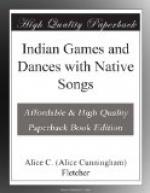Introduction.—These Dances in their purport and music are taken from the sacred rituals of the Omaha, the Osage and the Pawnee tribes. The richness and beauty of symbolism in the original language suffer a loss of native naivete in their English interpretation.
The American food plant known by the general term “Corn” was developed ages ago from certain native grasses. The Euchlaena luxurians found in Guatemala is probably an ancestor of the maize. The word “maize” belongs to the language of a people living by the Caribbean Sea and never was a universal term for corn among the Indians of our country. The tribes to which maize was known gave it a name derived from their own languages. So very many centuries have passed since corn was a grass that there is no way now of finding out when in the remote past the natives of this continent began the task of developing from a grass a staple article of food like the corn. The process required years of careful observation, manipulation and culture. Not only did the Indians accomplish this task but they took the plant from its tropical surroundings and acclimated it throughout the region east of the Rocky Mountains up to the country of short summers in the North; Cartier, in 1534, found it growing where the city of Montreal now stands.
From this hasty glance at the long history of the maize we can discern the natural sequence of its close relation to the thought and to the life of the Indian, and to a degree understand the love and the reverence with which the corn was held and regarded as a gift from God. Every stage of its growth was ceremonially observed and mentioned in rituals and songs.
Among the Omaha tribe when the time came for planting, four kernels from a red ear of corn were given to each family by the keeper of this sacred rite. These four red kernels were mixed with the ordinary seed corn, that it might be vivified by them and made to yield an ample harvest. Red is the symbolic color of life. In this ceremony is preserved a trace of the far-away time when all the precious seed corn was in the care of priestly keepers. The ceremony of giving out the four red kernels served to turn the thoughts of the people from a dependence solely on their own labor in cultivating corn to the life-giving power of Wakon’da dwelling within the maize.
In the Omaha Ritual Song of twenty-six stanzas which preceded the distribution of the four red kernels, the Corn speaks. It tells of its roots reaching in the four directions (where dwell the messengers that bring life), of the growth of its jointed stalk, of the unfolding of its leaves, of the changing color of the silk and of the tassel, of the ripening of the fruit, of the bidding of the people to come, to pluck and to eat.
The music of this Ritual Song is simple. It is here given with a very brief paraphrase of the words of the Ritual Song.




